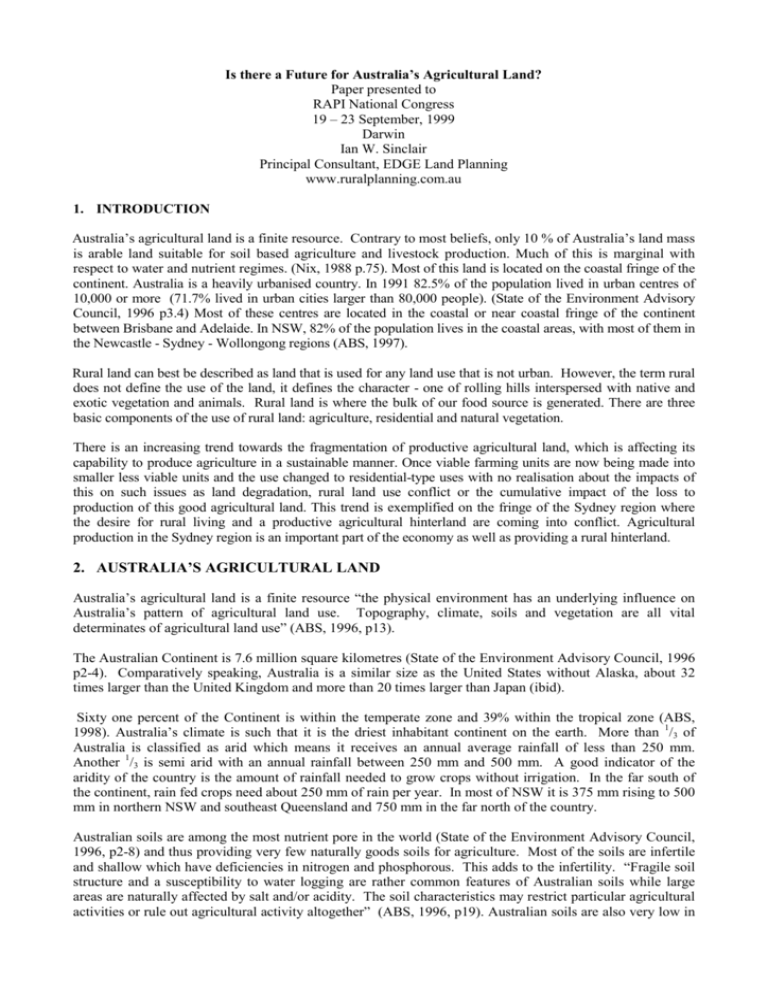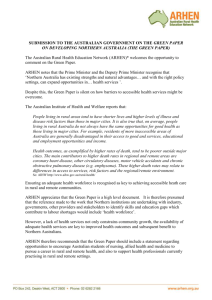Is there a Future for Australia's Agricultural Land
advertisement

Is there a Future for Australia’s Agricultural Land? Paper presented to RAPI National Congress 19 – 23 September, 1999 Darwin Ian W. Sinclair Principal Consultant, EDGE Land Planning www.ruralplanning.com.au 1. INTRODUCTION Australia’s agricultural land is a finite resource. Contrary to most beliefs, only 10 % of Australia’s land mass is arable land suitable for soil based agriculture and livestock production. Much of this is marginal with respect to water and nutrient regimes. (Nix, 1988 p.75). Most of this land is located on the coastal fringe of the continent. Australia is a heavily urbanised country. In 1991 82.5% of the population lived in urban centres of 10,000 or more (71.7% lived in urban cities larger than 80,000 people). (State of the Environment Advisory Council, 1996 p3.4) Most of these centres are located in the coastal or near coastal fringe of the continent between Brisbane and Adelaide. In NSW, 82% of the population lives in the coastal areas, with most of them in the Newcastle - Sydney - Wollongong regions (ABS, 1997). Rural land can best be described as land that is used for any land use that is not urban. However, the term rural does not define the use of the land, it defines the character - one of rolling hills interspersed with native and exotic vegetation and animals. Rural land is where the bulk of our food source is generated. There are three basic components of the use of rural land: agriculture, residential and natural vegetation. There is an increasing trend towards the fragmentation of productive agricultural land, which is affecting its capability to produce agriculture in a sustainable manner. Once viable farming units are now being made into smaller less viable units and the use changed to residential-type uses with no realisation about the impacts of this on such issues as land degradation, rural land use conflict or the cumulative impact of the loss to production of this good agricultural land. This trend is exemplified on the fringe of the Sydney region where the desire for rural living and a productive agricultural hinterland are coming into conflict. Agricultural production in the Sydney region is an important part of the economy as well as providing a rural hinterland. 2. AUSTRALIA’S AGRICULTURAL LAND Australia’s agricultural land is a finite resource “the physical environment has an underlying influence on Australia’s pattern of agricultural land use. Topography, climate, soils and vegetation are all vital determinates of agricultural land use” (ABS, 1996, p13). The Australian Continent is 7.6 million square kilometres (State of the Environment Advisory Council, 1996 p2-4). Comparatively speaking, Australia is a similar size as the United States without Alaska, about 32 times larger than the United Kingdom and more than 20 times larger than Japan (ibid). Sixty one percent of the Continent is within the temperate zone and 39% within the tropical zone (ABS, 1998). Australia’s climate is such that it is the driest inhabitant continent on the earth. More than 1/3 of Australia is classified as arid which means it receives an annual average rainfall of less than 250 mm. Another 1/3 is semi arid with an annual rainfall between 250 mm and 500 mm. A good indicator of the aridity of the country is the amount of rainfall needed to grow crops without irrigation. In the far south of the continent, rain fed crops need about 250 mm of rain per year. In most of NSW it is 375 mm rising to 500 mm in northern NSW and southeast Queensland and 750 mm in the far north of the country. Australian soils are among the most nutrient pore in the world (State of the Environment Advisory Council, 1996, p2-8) and thus providing very few naturally goods soils for agriculture. Most of the soils are infertile and shallow which have deficiencies in nitrogen and phosphorous. This adds to the infertility. “Fragile soil structure and a susceptibility to water logging are rather common features of Australian soils while large areas are naturally affected by salt and/or acidity. The soil characteristics may restrict particular agricultural activities or rule out agricultural activity altogether” (ABS, 1996, p19). Australian soils are also very low in organic matter and thus are not highly productive for plants and animals. In total, only a small area of the country has soils with the valuable characteristics of being deep and well drained with high fertility and high water holding capacity. The major area of agricultural activity and good soils is on the coastal fringe and to the fringe part of the inland to the eastern and southern western tip of the continent. When one considers the locations of the major agricultural areas, it is evident that much of the productive land, especially for intensive uses such as fresh vegetables are located along the coastal strip of the continent. 3. THE SPATIAL DISTRIBUTION OF AUSTRALIA’S POPULATION “The two main distinguishing characteristics of Australia’s settlement pattern are the spread of urbanisation along the coast line and the concentration of Australia’s population in five large cities.” (State of the Environment Advisory Council 1996, p 3-8). Australia’s resident population at 30 December 1998 was 18.87 million (ABS 199, p 1). The population is growing at a rate of 1.3% per annum. The distribution of Australia’s population is such that it is concentrated in two separate coastal regions. These being the south west of Western Australia and the south east and east coast focused on Southern Queensland, NSW and Victoria. In both areas the population is concentrated in urban centres mainly in the capital cities. “Half the area of the continent contains only 0.3% of the population and the most densely populated 1% of the continent contains 84% of the population. (ABS 1998 p135). Australia is widely recognised as one of the world’s most urbanised countries. In 1996, 79.5% of the population lived in towns and cities of 5,000 or more. This is an increasing trend and in the past 75 years, the population living in cities has gone from 49.7% to 79.5%. Similarly, the population growth has been higher in metropolitan areas than other urban areas. (Budge and Sinclair, 1998). “The worlds population is urbanising much faster than it is growing…by the year 2005, half of the worlds people will live in an urban area; by the year 2025 that number will be about 2 out of 3” (World Resources Institute, 1994, p 31). Between 1993 and 1998 the country experienced an average annual population growth of 1.2% per annum (ABS 1999). Much of this population growth was concentrated along the east coast with almost all of the Local Government Areas experiencing growth. In fact, most Local Government areas along the NSW and Southern Queensland coast increased their population density by more than 1 person per square kilometre (ABS 1998, p137). The localities which experienced the greatest amount of population growth were those located on the fringe of the major metropolitan areas being the capital cities of Brisbane, Sydney and Melbourne. 4. RURAL LAND USE CONFLICT The presence of agriculture and non-rural land use in the one location can often generate conflict due to their potential incompatibility. Agriculture can affect adjoining small rural lots, which are used essentially for residential purposes. Similarly, the presence of small rural lots creates an adverse influence on the continued operation of the agricultural enterprise. The issue of rural-urban conflict can arise when there is no separation between incompatible uses, let alone the misunderstanding, which may exist about the purpose and character of a district. Land use conflicts may arise in such situations through noise, odour, farm chemicals, light, visual amenity, dogs, and stock damage and weed infestation, to name just a few. 5. GROWTH MANAGEMENT It can be seen therefore that there is a need to manage the growth of our towns and cities, particularly the state capitals and those on the coastal fringe. This is needed because we need to protect our important but finite agricultural land. It has been shown that, contrary to most beliefs, we can’t just push agriculture into the centre of the continent. The lack of rainfall, low fertility and the dryland salinity problems currently being faced in inland Australia exemplify this. It is recognised that there has to be growth of our towns and cities. Growth of urban areas can go in two directions: outwards (horizontal) or upwards (vertical). Outward growth is called urban sprawl and upward growth is called urban consolidation. The basic fact is if we can achieve more vertical growth, there will be less need for horizontal growth. It is the balance between the vertical and horizontal which is what we strive for as planners. Achieving the balance is called growth management. This is an important part of preserving agricultural land. It is necessary for planners to recognise the importance of agricultural land when looking at managing the growth of urban areas of Australia. 6. INITIATIVES TO RECOGNISE AND PRESERVE AGRICULTURAL LAND There are three basic ways to recognise and preserve agricultural land: land use zoning, monetary compensation or right to farm legislation. Land use zoning entails placing restrictions on the use of the land by way of statute. Monetary compensation can take two forms: purchase of development rights or tradeable development rights. Right to Farm legislation, basically, takes away the common law right to sue for nuisance caused by a farmer to a neighbouring rural residential use. Land use zoning is practised in Australia as the principal method for controlling the development of land. It is a system where land is designated for a principal use and uses that are considered not to be suitable or compatible with the principal use are prohibited. There is also the ability to require certain uses to submit an application for use of the land, which is then assessed having regard to a set of published assessment criteria. The issue of recognising the importance of Agricultural land as a growth management constraint has been done by Wollondilly Shire Council and others to varying degrees of completeness. Wollondilly Shire Council prepared its Agricultural Lands Study in 1993 which recognised the importance of agricultural land in the Shire and the whole Sydney region. This was followed by the Review of Rural Lands LEP and DCP’s for Agricultural Lands and Rural Living zones. The LEP introduced three new zones: an Agriculture Zone, Agricultural Landscape as well as a Rural Living zone. It is important for the zone names to recognise the use and not the character. Rural is a character and agriculture is a use. Similarly Rural Residential uses come in two different forms - Rural Living and Rural Urban Fringe. Rural Urban Fringe development is that style of development, which is within the servicing catchments and in close proximity to an urban centre. It may have reticulated water and in fact may have reticulated sewerage although most effluent disposal will be on site. It will also have a garbage service. The lot size is generally in the range of 4000 square metres to 1 hectare and it is in "estate" style of development. Rural Living development is a residential use of the land within a rural environment. It is not necessarily near an existing urban centre and does not have reticulated water or any other form of service, which would generally be provided in a rural residential zone or urban centre. The density in Wollondilly is one dwelling per 4 hectares with a minimum of 2 hectares and any subdivision must be carried out having due regard to the constraints of the land It is important to separate the uses from conflicting with each other and as such in the rural living zone intensive agriculture is prohibited and rural residential lots can not be established in the agriculture zone. Monetary compensation takes two forms. Firstly, Purchase of Development Rights involves a farmer selling the development rights to the farm to a government or non-government organisation. In return a covenant is taken out over the land to ensure that the land is only used for agricultural purposes. The purchase of development rights can also be used to require soil and water management to be undertaken on the property. The property is inspected a regular intervals to ensure that tit is being used properly. Transfer of Development Rights occurs where land is declared to be in a preservation zone and kept for agriculture. The development rights to this land can be purchased by developers who whish to gain an increase in the development potential of land declared to be in a development zone. Both of these methods exist in the United States. Of the two, the Purchase of Development Rights is the more successful. Both are applicable to the Australian situation with the issues of Transfer of Development Rights already in existence for heritage sites in the city of Sydney. Its application to agricultural land is problematical under the existing administration of the various planning legislation. Right to farm legislation basically allows farmers to have a right to continue farming as long as they are carrying out “good management practices” even if there is a loss of amenity for surrounding rural residential uses. It precludes surrounding rural residential dwellers from suing in the courts for nuisance caused to them by the farm noises, odours or dust. This is a good concept in theory but in practice is difficult to implement effectively as it does not provide a solution to both sides of the problem. The farmer is able to continue operating but the surrounding rural residential users have not solved their amenity issue. A more effective term is “letting farmers farm”. There is a need to educate the community about farming and its impacts. Rural land use conflict often arises from an unrealistic attitude to agricultural practices and a lack of understanding of the issues and importance of agriculture. The carrying out of an education campaign is a much better approach than a litigious one with right to farm legislation. Of these three, only land use zoning is practiced in NSW. Although, Tasmania and Western Australia have Right to Farm legislation, their effectiveness as a tool to preserve agricultural land has been questioned. Purchase of Development Rights and Tradeable Development rights are not used for the recognition and preservation of agricultural land in Australia. However, it is considered that there should be an investigation into their applicability or modification for the Australia political and social environments. It may be that one, two or a combination of them or a modified version is applicable, but without investigation we will not know. 7. CONCLUSION Australia’s agricultural land is a finite resource. The good land is located on the coastal fringe of the continent. This is where the population growth is occurring. The growth of population is coming into conflict with the agricultural practices, which is causing them to relocate. There is a need to manage the growth of our towns and cities so that we can achieve a balance between horizontal and vertical growth. We also need to recognise the importance of our agricultural land. There are various methods use for the preservation of agricultural land in use throughout the world. They should be evaluated and discussed to ascertain the benefits of using them for the Australian situation. There is a need to act now. If we do we can achieve the balance and be sustainable by growing food as well as growing houses. If we don’t we run the risk of loosing the good agricultural land and instead of rural Australia we will have rural residential Australia. BIBLIOGRAPHY Australian Bureau of Statistics, 1997, NSW Regional Statistics, ABS, Canberra. Budge, T. and Sinclair, I.W., 1998 Rural Australia: Change, Decline and New Directions – How Urbanisation Killed Crocodile Dundee, Paper presented to the American Planners Association Conference, Boston, April, 1998 Daniels, T. and Bower, D, 1997, Holding Our Ground - Protecting America’s Farms and Farmland, Island Press, Washington. NSW Agriculture, 1998, Strategic Plan for Sustainable Agriculture - Sydney Region, NSW Agriculture, Orange. Nix, N., 1978, Availability of Land for Energy. Cropping Australia. Alcohol Fuels Conference, Sydney. Nix, N., 1988, Australia's Natural Resources, in How many More Australians, Day, L.H. & Rowland, D.T. Longman, Cheshire. Sinclair, I.W., 1999, Growth Management and Agricultural Land Paper presented to UNSW Planning Law and Practice Short Course, Kensington. State of the Environment Advisory Council, 1996, Australia State of the Environment 1996, CSIRO Publishing, Melbourne. Wollondilly Shire Council, 1993, Wollondilly Agricultural Lands Study, Wollondilly Council, Picton. Wollondilly Shire Council, 1996, Review of Rural Land Report, Wollondilly Shire Council, Picton.





